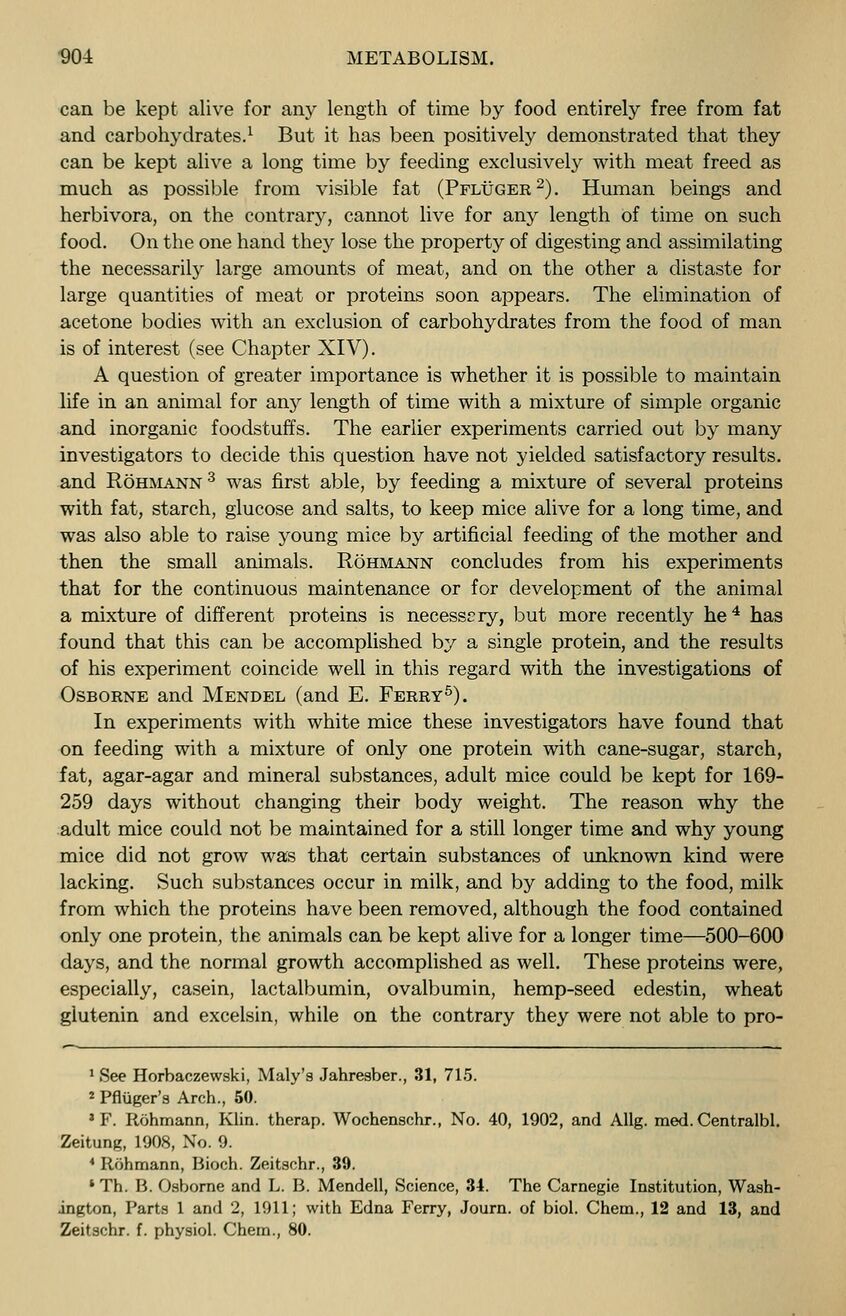
Full resolution (JPEG) - On this page / på denna sida - XVII. Metabolism - II. Metabolism in Starvation and with Insufficient Nutrition

<< prev. page << föreg. sida << >> nästa sida >> next page >>
Below is the raw OCR text
from the above scanned image.
Do you see an error? Proofread the page now!
Här nedan syns maskintolkade texten från faksimilbilden ovan.
Ser du något fel? Korrekturläs sidan nu!
This page has never been proofread. / Denna sida har aldrig korrekturlästs.
904 METABOLISM.
can be kept alive for any length of time by food entirely free from fat
and carbohydrates. 1
But it has been positively demonstrated that they
can be kept alive a long time by feeding exclusively with meat freed as
much as possible from visible fat (Pfluger 2
) . Human beings and
herbivora, on the contrary, cannot live for any length of time on such
food. On the one hand they lose the property of digesting and assimilating
the necessarily large amounts of meat, and on the other a distaste for
large quantities of meat or proteins soon appears. The elimination of
acetone bodies with an exclusion of carbohydrates from the food of man
is of interest (see Chapter XIV)
.
A question of greater importance is whether it is possible to maintain
life in an animal for anjr
length of time with a mixture of simple organic
and inorganic foodstuffs. The earlier experiments carried out by many
investigators to decide this question have not yielded satisfactory results,
and Rohmann 3
was first able, by feeding a mixture of several proteins
with fat, starch, glucose and salts, to keep mice alive for a long time, and
was also able to raise young mice by artificial feeding of the mother and
then the small animals. Rohmann concludes from his experiments
that for the continuous maintenance or for development of the animal
a mixture of different proteins is necessery, but more recently he 4
has
found that this can be accomplished by a single protein, and the results
of his experiment coincide well in this regard with the investigations of
Osborne and Mendel (and E. Ferry5
).
In experiments with white mice these investigators have found that
on feeding with a mixture of only one protein with cane-sugar, starch,
fat, agar-agar and mineral substances, adult mice could be kept for 169-
259 days without changing their body weight. The reason why the
adult mice could not be maintained for a still longer time and why young
mice did not grow was that certain substances of unknown kind were
lacking. Such substances occur in milk, and by adding to the food, milk
from which the proteins have been removed, although the food contained
only one protein, the animals can be kept alive for a longer time—500-600
days, and the normal growth accomplished as well. These proteins were,
especially, casein, lactalbumin, ovalbumin, hemp-seed edestin, wheat
glutenin and excelsin, while on the contrary they were not able to pro-
1
See Horbaczewski, Maly’s Jahresber., 31, 715.
2
Pfliiger’s Arch., 50.
* F. Rohmann, Klin, therap. Wochenschr., No. 40, 1902, and Allg. med. Centralbl.
Zeitung, 1908, No. 9.
* Rohmann, Bioch. Zeitschr., 39.
* Th. B. Osborne and L. B. Mendell, Science, 34. The Carnegie Institution, Wash-
ington, Parts 1 and 2, 1911; with Edna Ferry, Journ. of biol. Chem., 12 and 13, and
Zeitschr. f. physiol. Chem., 80.
<< prev. page << föreg. sida << >> nästa sida >> next page >>